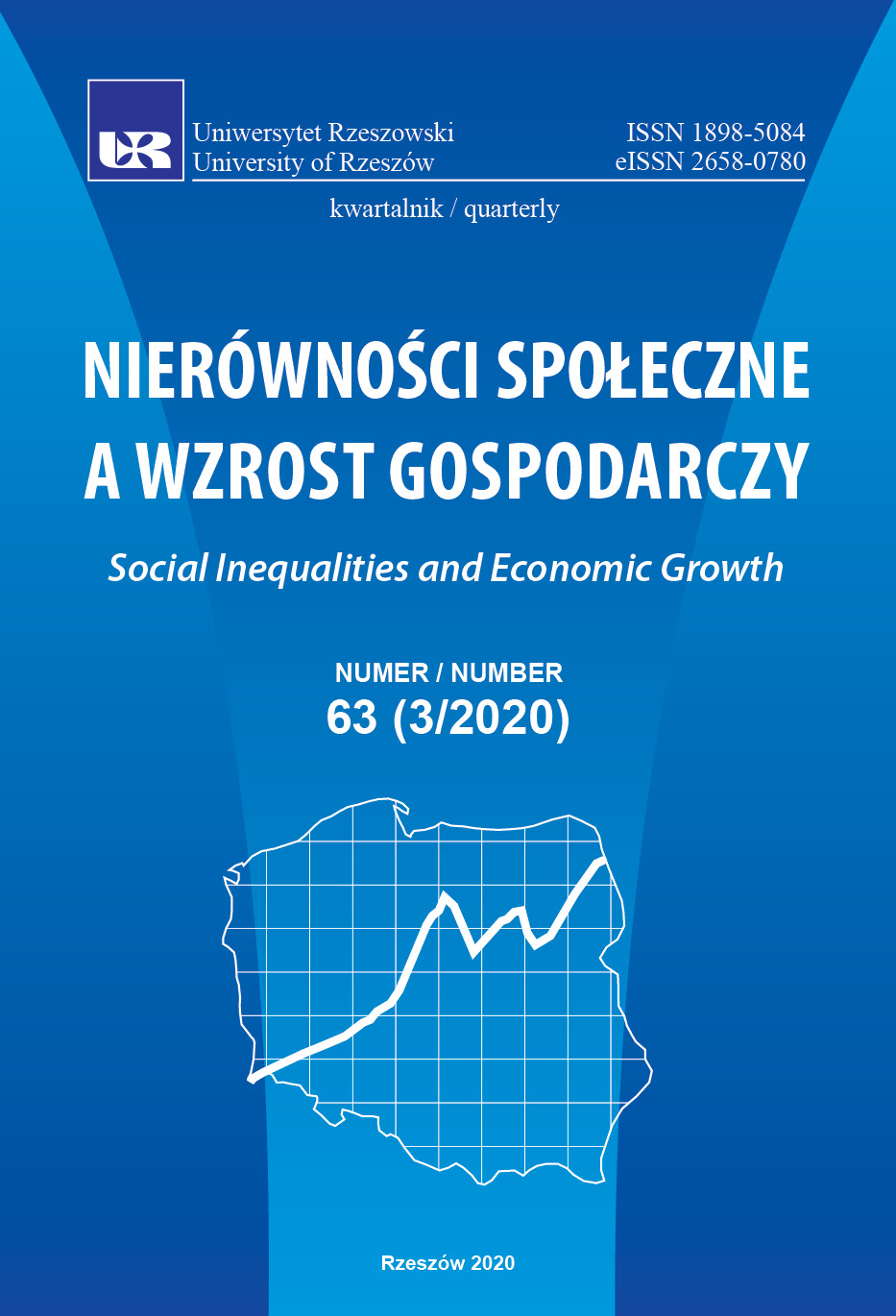Inequality of opportunity – gender bias in education in Pakistan
DOI:
https://doi.org/10.15584/nsawg.2020.3.11Keywords:
gender inequality, inequality of opportunity, education, economic growth, economic development, PakistanAbstract
The subject matter of the paper is inequality of opportunity (IO). Contemporarily, as part of IO, gender bias in education is most likely to be a constraint for growth and development in developing countries. The focus is on gender bias in education in Pakistan, which is a widely discussed problem thanks to the Nobel Prize laureate Malali Yousufzai. The goal is to present the premise and potential consequences of unequal access to education for Pakistanis, and to bring the specifics of the country into clearer focus. The thesis is that gender bias in education in Pakistan is determined by various and deeply rooted factors that place equal access to education in the realm of a distant goal, hampering the growth and development of the economy. The research methods used were a critique of the literature, analysis of statistical data, documents and online sources as well as elements of case study. Plans concerning education have been sketched in SDG-4 and in the document “Pakistan 2025”, but despite some improvements, Pakistan is still a country where one’s future depends on whether one is male or female. A lack of access to education for girls is part of a broader landscape of gender and spatial inequality. The findings suggest that the main circumstances for the exclusion of girls from education are culture, poverty and the state. If recommendations for these areas are not implemented, gender bias will remain one of the barriers to the growth and development of Pakistan.
Downloads
References
Ayiar, S., Ebeke, CH. H. (2019). Inequality of Opportunity, Inequality of Income and Economic Growth. IMF Working Paper, WP/19/34, 1–22. DOI: 10.5089/9781484396988.001.
Brzeziński, M., Magda, I. (2016). Inequality of opportunity in Central and Eastern Europe: accounting for changes over time. IBS Working Paper, 5/2016, 1–48.
Dagia, N., Ismail, Z. (2018). UN Women report shows worrying degree of gender inequality in Pakistan. Retrieved from: https://tribune.com.pk/story/1634815/1-un-wom-en-report-shows-worrying-degree-gender-inequality-pakistan/ (2019.08.25).
Central Asia Institute (2016). Retrieved from: https://centralasiainstitute.org/education-can-end-child-marriage/ (2019.08.10).
Daily Times (2018). Retrieved from: https://dailytimes.com.pk/335869/gender-gap-index/ (2019.07.15).
Ferreira, F. H. G., Lakner, Ch., Lugo, M. A., Özler, B. (2014). Inequality of opportunity and economic growth: a cross-country analysis. Policy Research Working Paper 6915, 1–38. DOI: 10.1596/1813-9450-6915.
Ferreira, F. H. G., Lakner, Ch., Lugo, M. A., Özler, B. (2018). Inequality of opportunity and economic growth: how much can cross-country regressions really tell us? Review of Income and Wealth, 64(4), 800–827. DOI: 10.1111/roiw.12311.
GCPEA (2009). Retrieved from: http://www.protectingeducation.org/safeschoolsdeclaration (10.09.2019).
Howitt, P. (2005). Health, Human Capital and Economic Growth: A Schumpeterian Perspective. Brown University, February 9. Retrieved from: https://www.brown.edu/Departments/Economics/Faculty/Peter_Howitt/publication/PAHO.pdf (2019.08.10).
Human Rights Watch (2018a). Pakistan: Girls Deprived of Education. Retrieved from: https://www.hrw.org/news/2018/11/12/pakistan-girls-deprived-education (2019.09.10).
Human Rights Watch (2018b). Shall I Feed My Daughter, or Educate Her? Barriers to Girls’ Education in Pakistan. Retrieved from: https://www.hrw.org/report/2018/11/12/shall-i-feed-my-daughter-or-educate-her/barriers-girls-education-pakistan (2019.09.10).
Ijaz, S. (2017). Pakistan Should End Child Marriage. Retrieved from: https://www.hrw.org/news/2017/10/12/pakistan-should-end-child-marriage (2019.09.15).
Korinek, J. (2005). Trade and gender: issues and interactions. OECD Trade Policy Working Paper, 24, Paris, 1–22.
Kremer, M., Chen, D. (2002). Income-Distribution Dynamics with Endogenous Fertility. Journal of Economic Growth, 7, 227–258. DOI: 10.1257/aer.89.2.155.
Lefranc, A., Pistolesi, N., Trannoy, A. (2009). Equality of opportunity and luck: Definitions and testable conditions, with an application to income in France. Journal of Public Economics, 93, 1189–1207. DOI: 10.1016/j.jpubeco.2009.07.008.
Lewis, B. (2002). What went wrong? Retrieved from: https://www.theatlantic.com/magazine/archive/2002/01/what-went-wrong/302387/ (2019.08.20).
Marrero, G. A., Rodríguez, J. G. (2010). Inequality of opportunity and growth. Working Paper Series. Society for the Study of Economic Equality. ECINEQ WP, 154, 1–42.
Ministry of Planning, Development & Reform Government of Pakistan (2014). Pakistan 2025. One Nation – One Vision. Executive Summary. Planning Commission.
Pakistan Economic Survey 2018–2019. Economic Adviser’s Wing, Finance Division Government of Pakistan, Islamabad.
Rawls, J. (1999). A Theory of Justice. Revised edition. Massachusetts: The Belknap Press of Harvard, University Press Cambridge.
Roemer, J. E. (1998). A pragmatic theory of responsibility for the egalitarian planner. Philosophy and Public Affairs, 22(2), 146–166.
Shaheen, S., Awan, M. S., Cheema, A. R. (2016). Measuring inequality of opportunity in Pakistan: parametric and non-parametric analysis. Pakistan Economic and Social Review, 54(2),165–190.
Tusińska, M. (2016). Finding pro-growth income inequality: mission impossible? In: D. Mihanovic, A. Hunjet, Z. Primorac (Eds.), Book of Proceedings. 18th International Scientific Conference on Economic and Social Development – “Building Resilient Society” (pp. 742–749). Zagreb, Croatia, 9–10 December 2016.
UN (1948). Retrieved from: https://www.un.org/en/universal-declaration-human-rights/(2019.08.20).
UN (2016). Retrieved from: https://www.un.org/sustainabledevelopment/wp-content/uploads/2016/08/5.pdf (2019.07.15).
UN (2017). Retrieved from: https://www.un.org/sustainabledevelopment/wp-content/uploads/2017/02/4.pdf (2019.07.15).
UN (2019). Retrieved from: https://www.un.org/sustainabledevelopment/gender-equality/(2020.01.02).
UNDP (2018a). Retrieved: from http://hdr.undp.org/en/countries/profiles/PAK (2019.08.05).
UNDP (2018b). Retrieved from: http://hdr.undp.org/en/indicators/181406 (2019.08.16).
UNESCO (2016). Girls’ and Women’s Literacy with A Lifelong Learning Perspective: Issues, Trends and Implications for the Sustainable Development Goals. Paris: UNESCO.
UNICEF (2015). The investment case for education and equity.
Waleczek, M. (2013). Nierówny dostęp do edukacji wczesnoszkolnej ze względu na płeć w Islamskiej Republice Pakistanu. Cieszyński Almanach Pedagogiczny 2, 196–213.
WEF (2018). https://www.weforum.org/reports/the-global-gender-gap-report-2018 (15.07.2019).
World Bank (2005). Pakistan – Country gender assessment – Bridging the gender gap: opportunities and challenges. Washington: The World Bank. Retrieved from: http://siteresources.worldbank.org/PAKISTANEXTN/Resources/293051-1146639350561/Cover&Preliminaries.pdf (2019.08.10).
World Bank, World Development Indicators. Retrieved from: https://databank.worldbank.org/reports.aspx?source=2&series=SE.ADT.1524.LT.FM.ZS&country=PAK# (2019.07.22).
World Bank, www1.worldbank.org/poverty/visualizeinequality/Files/Documentation/HOI-Methodology.pdf (2019.07.10).
World Bank, https://www.worldbank.org/en/topic/poverty/lac-equity-lab1/equality-of-opportunities/hoi (2019.07.10).
Zaidi, Y., Farooq, S. (2018). Rural Women in Pakistan. Status Report 2018 UN Women Pakistan. Islamabad: Center of Gender and Policy Studies.
Downloads
Published
How to Cite
Issue
Section
License
Copyright (c) 2020 University of Rzeszow

This work is licensed under a Creative Commons Attribution-ShareAlike 4.0 International License.


